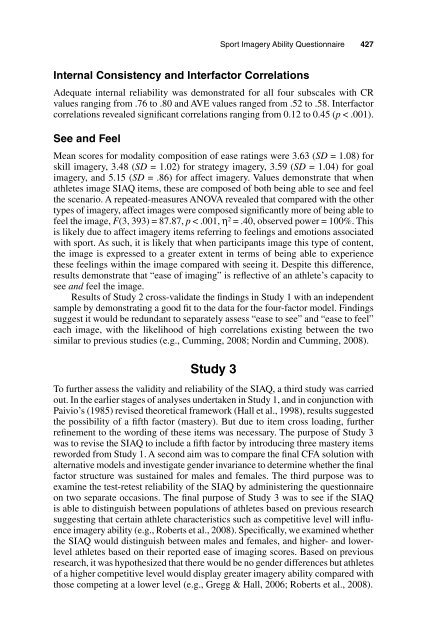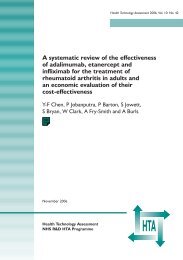Measuring Athlete Imagery Ability: The Sport ... - ResearchGate
Measuring Athlete Imagery Ability: The Sport ... - ResearchGate
Measuring Athlete Imagery Ability: The Sport ... - ResearchGate
Create successful ePaper yourself
Turn your PDF publications into a flip-book with our unique Google optimized e-Paper software.
<strong>Sport</strong> <strong>Imagery</strong> <strong>Ability</strong> Questionnaire 427<br />
Internal Consistency and Interfactor Correlations<br />
Adequate internal reliability was demonstrated for all four subscales with CR<br />
values ranging from .76 to .80 and AVE values ranged from .52 to .58. Interfactor<br />
correlations revealed significant correlations ranging from 0.12 to 0.45 (p < .001).<br />
See and Feel<br />
Mean scores for modality composition of ease ratings were 3.63 (SD = 1.08) for<br />
skill imagery, 3.48 (SD = 1.02) for strategy imagery, 3.59 (SD = 1.04) for goal<br />
imagery, and 5.15 (SD = .86) for affect imagery. Values demonstrate that when<br />
athletes image SIAQ items, these are composed of both being able to see and feel<br />
the scenario. A repeated-measures ANOVA revealed that compared with the other<br />
types of imagery, affect images were composed significantly more of being able to<br />
feel the image, F(3, 393) = 87.87, p < .001, η 2 = .40, observed power = 100%. This<br />
is likely due to affect imagery items referring to feelings and emotions associated<br />
with sport. As such, it is likely that when participants image this type of content,<br />
the image is expressed to a greater extent in terms of being able to experience<br />
these feelings within the image compared with seeing it. Despite this difference,<br />
results demonstrate that “ease of imaging” is reflective of an athlete’s capacity to<br />
see and feel the image.<br />
Results of Study 2 cross-validate the findings in Study 1 with an independent<br />
sample by demonstrating a good fit to the data for the four-factor model. Findings<br />
suggest it would be redundant to separately assess “ease to see” and “ease to feel”<br />
each image, with the likelihood of high correlations existing between the two<br />
similar to previous studies (e.g., Cumming, 2008; Nordin and Cumming, 2008).<br />
Study 3<br />
To further assess the validity and reliability of the SIAQ, a third study was carried<br />
out. In the earlier stages of analyses undertaken in Study 1, and in conjunction with<br />
Paivio’s (1985) revised theoretical framework (Hall et al., 1998), results suggested<br />
the possibility of a fifth factor (mastery). But due to item cross loading, further<br />
refinement to the wording of these items was necessary. <strong>The</strong> purpose of Study 3<br />
was to revise the SIAQ to include a fifth factor by introducing three mastery items<br />
reworded from Study 1. A second aim was to compare the final CFA solution with<br />
alternative models and investigate gender invariance to determine whether the final<br />
factor structure was sustained for males and females. <strong>The</strong> third purpose was to<br />
examine the test-retest reliability of the SIAQ by administering the questionnaire<br />
on two separate occasions. <strong>The</strong> final purpose of Study 3 was to see if the SIAQ<br />
is able to distinguish between populations of athletes based on previous research<br />
suggesting that certain athlete characteristics such as competitive level will influence<br />
imagery ability (e.g., Roberts et al., 2008). Specifically, we examined whether<br />
the SIAQ would distinguish between males and females, and higher- and lowerlevel<br />
athletes based on their reported ease of imaging scores. Based on previous<br />
research, it was hypothesized that there would be no gender differences but athletes<br />
of a higher competitive level would display greater imagery ability compared with<br />
those competing at a lower level (e.g., Gregg & Hall, 2006; Roberts et al., 2008).
















